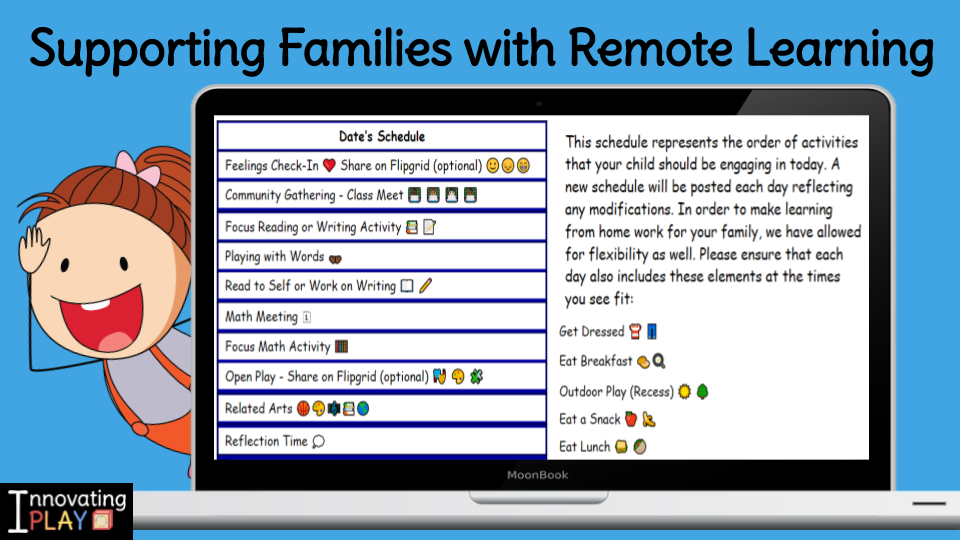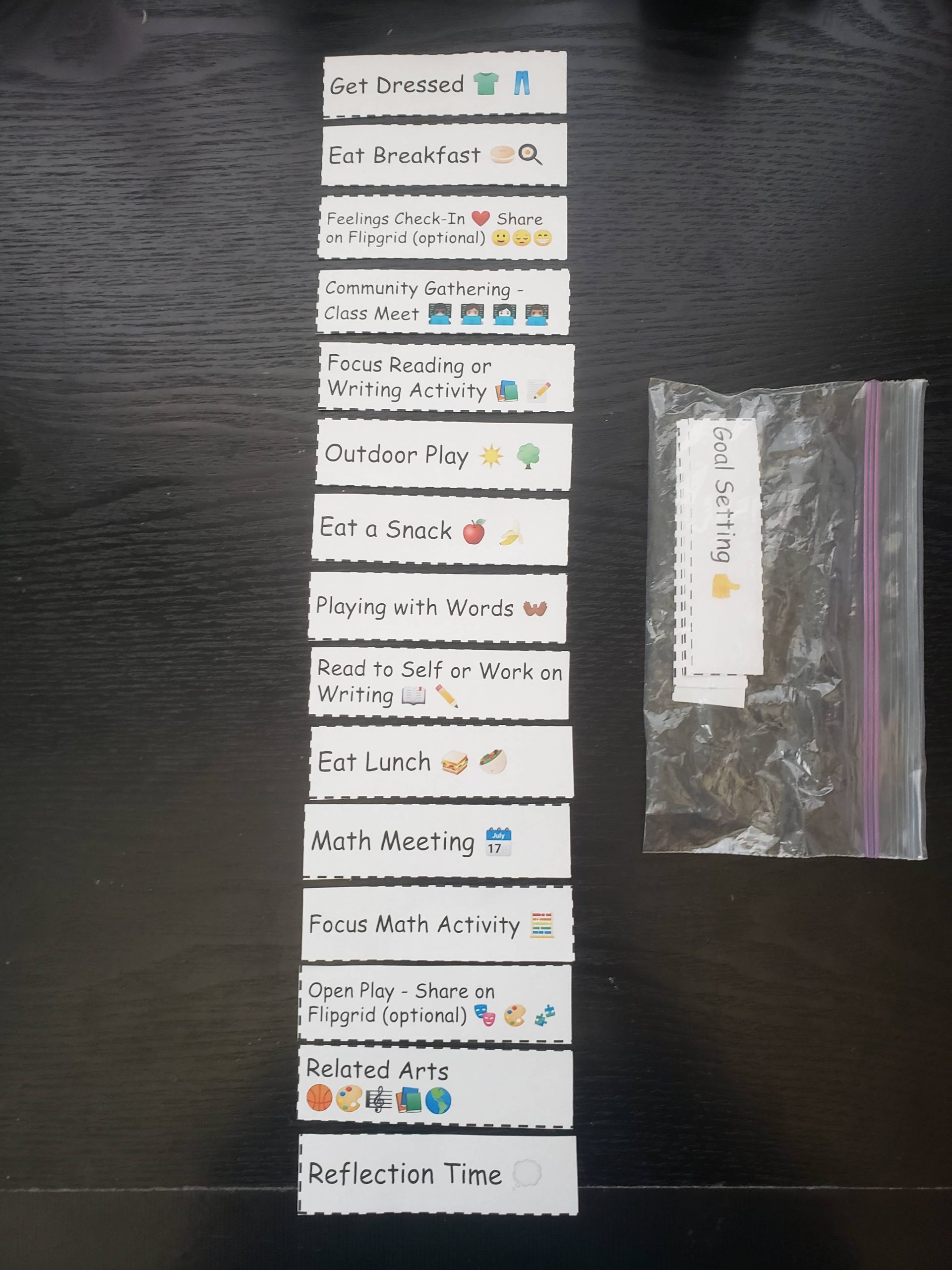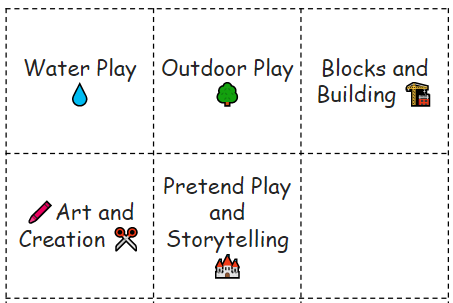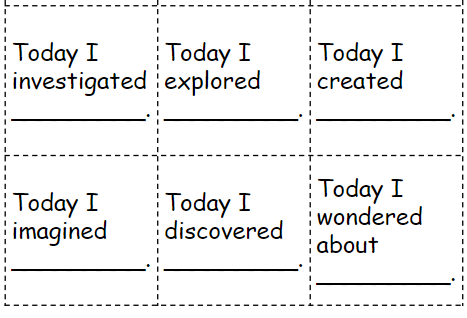
Getting ready for learning at home with little ones means more than charging your computer. While screen time may be a necessary part of communicating and documenting learning experiences, hands-on experiences away from the screen are critical for proper child-development. In this post we will share ideas for helping families to prepare for what remote learning looks like away from the screen. You will also find that we are offering you a language you can use with families, consisting of purpose-filled descriptions so that big picture ideas we have as educators can be articulated and communicated to families.
Daily Schedule for Remote Learning
While there will most likely be some kind of framework for timing that works with the school day, learning at home will look a little different for each family. No matter what the situation, all children (and families) will benefit from a clear schedule that defines what the day will look like when learning at home. A visual schedule provides young children with a sense of security, understanding of the flow for the day, and accountability for participation in each part. This is also a wonderful opportunity to develop independence and self-help skills in young children.
This Daily Schedule for Remote Learning template is intended to empower and support children and families in developing a routine in order to engage in effective learning at home. Text boxes containing words and visuals for activities may be edited and moved around to reflect the schedule on any given day. The schedule on the slide may be shared with families through the platform of your choice. Options for sharing include: downloading the slide as an image and uploading to a communication tool (i.e. Seesaw, Remind, Class Dojo, etc.), attaching to a Google Classroom assignment, embedding on a Google Site, or including this slide within a different Google Slide deck for sharing. This resource may be used in conjunction with the printable Family Schedule Cards.
Click here to access The Daily Schedule for Remote Learning template
Family Schedule Cards
These Family Schedule Cards may be used with the Daily Schedule for Remote Learning resource in order to communicate daily updates to the schedule as needed. The cards may be printed, cut, and reused daily by families at home. Children may put the cards in order to show the events of the day. As an activity is completed, the corresponding card may be removed and stored for the following day.
Click here to access the Family Schedule Cards template

Creating a Learning Space
In the classroom, teachers put lots of time into creating learning spaces that will work for children. Encourage families to help children to take ownership of their learning by allowing them to contribute to decisions about the look, feel, and organization of the space. Below are some ideas you can share with families to consider when setting up a learning space at home:
- Independent access to materials organized ahead of time
- Visual references – this may include things such an alphabet, word, or number charts. These do not need to be fancy and can be created together!
- Good lighting and options for seating – While a table or desk will work beautifully for some activities, also consider soft and cozy spots for reading or working. Having options such as attaching a paper to a wall for writing or drawing, or using a clipboard or hard surface to complete an activity laying on their belly on the floor are both great strategies for proper physical development.
- Post a weekly goal – In our classrooms, children set independent goals at the beginning of each week. Each goal is selected by the child, and is based on something that they feel is tricky now, but they would like to practice so that they can improve. When we moved to remote learning in the spring, children continued goal setting and shifted their focus to goals that matched their challenges for learning at home. Ideas included focuses such as: cooperating with grown-ups, making healthy choices, getting enough sleep, completing all school work. Goal recording sheets offer children a space to reflect on their progress each day. Photos/video reflections were completed through Seesaw, offering the opportunity for teacher feedback and support.
Click here to access the Remote Learning Goal Setting template
Preparing a Space for Intentional, Open-Ended Play
Many early childhood educators have some type of open-ended playtime included as part of the school day. Why? For us, it goes beyond rewarding kids for working hard on academic tasks. There are a myriad of reasons for prioritizing play. For the purpose of supporting families at home, we want to highlight that open-ended play offers opportunities for children to explore, discover, create, and imagine new possibilities. During quality play experiences, children become problem solvers and storytellers – which nurtures brain development and supports them in making learning connections. All of this is to say that we want NEED our kids to be making purposeful, independent play choices as part of their remote learning experience.
Communicating Play Types to Families
In some cases, there may be overlap in the materials and toys children would access at school and at home. At home, there may even be more options for kids to engage in during play. We want to maximize the quality of play opportunities and to help families to navigate these options. In doing so, we can work together to support children in making purposeful, independent play choices. Below we are sharing play choice cards children can use and some ideas you can offer your families for open-ended play at home.

- Water Play: A sink filled with water, or buckets of water outdoors open up wonderful opportunities for sensory exploration. Children can explore properties of water as they fill containers, develop life skills as they wash materials in soapy water, explore writing with paintbrushes and on the driveway or sidewalk, investigate changes in water when soap is added, etc. Water play provides endless possibilities for exploration and discovery.
- Outdoor Play: One of the wonderful benefits of learning at home may be the ability to engage in more time outdoors. Daily walks, nature collections, outdoor investigation, gross-motor movement, investigation of seasonal changes, are all part of nurturing curiosity and a sense of wonder in the world. Remember that you could begin outdoor exploration time with the same question every day and come up with a new answer every time – no fancy lesson or materials required! “What will we discover about the world today?”
- Blocks and Building: Block play is critical in the early years as it provides endless opportunities to support mathematical and spatial reasoning, problem-solving, creation, imagination, balance, as well as fine and motor skills. Children should have access to open-ended building materials. This could mean anything from Legos (open-ended collections offer more possibilities than pre-made kits) to collections of boxes from around the house. Outdoor building materials can include rocks, sticks, or other natural materials. The point is that building materials can be found anywhere if you open up your imaginations together!
- Art and Creation: Keeping a variety of simple, open-ended art materials on hand will support children in completing academic activities, and offer access to options for free exploration. Including time for creation and imagination through art is an important part of nurturing children’s sense of self and confidence in expression.
- Pretend Play and Storytelling: When children engage in pretend play, they are engaging in the important experience of processing their world. They are solidifying their understanding of the world they are in, at the same time they are imagining possibilities and wondering about things that make them curious. They are developing oral language skills, vocabulary, sequencing, observation, and expression. They are asserting their independence as capable creators and thinkers. Pretend play is not taking away from their learning time, it is recognizing the very essence of their learning. Allowing for storytelling and pretend play at home establishes a sense of value and recognizes the importance of this key element of childhood. This can also help to balance the academic expectations of the day, and will go a long way in supporting cooperation between children and caregivers when navigating learning at home.
The Play Choice Cards template also includes cards with sentence starters have been provided and may be used to support oral language and vocabulary development. We are encouraging our children reflect and share about their play experience on Flipgrid or with someone at home as closure to their open-ended playtime.

Click here to access the Play Choice Cards template
Redefining Learning Communities
As we redefine possibilities for educational models, children and families will need support in any number of ways. Just as we must be transparent in the process of using technology effectively and thoughtfully, we also have the opportunity to support family understanding of the valuable aspects of childhood and child development that remain the same. It is a chance to empower families as contributors and creators of rich learning spaces in new ways. We have the chance to shift from learning in classrooms to learning in communities. Together, we can establish the valuable contributions made by each member of the community as we move forward in growing and learning together.
